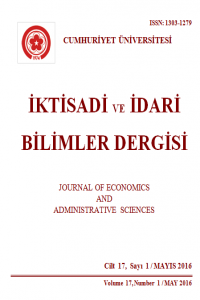Abstract
Bu çalışmada ekonomik büyümenin sağlanmasında kadın işgücüne katılımın rolü araştırılmıştır. Araştırmada yüksek gelirli ülkeler ve üst orta gelirli ülkeler için 1990-2013 periyodunu kapsayan mutlak ve koşullu yakınsama analizleri yapılmıştır. Analizlere göre her iki ülke grubunda da kişi başına düşen gelirin süreç boyunca arttığı, yani mutlak yakınsamanın olduğu tespit edilmiştir. Ayrıca koşullu yakınsama analizi sonuçları ise kadın işgücüne katılım oranlarının yüksek gelirli ülkelerde ekonomik büyümeye olumlu yönde, üst orta gelirli ülkelerde ise olumsuz yönde etkilerde bulunduğunu ortaya koymuştur. Sonuç olarak üst orta gelirli ülkelerin yüksek gelirli ülkeler sınıfına yükselebilmesi için kadın işgücüne katılımı artıracak politikaların geliştirilmesi gerekliliği ortaya çıkmıştır.
References
- Barro, R.J. ve Sala-i-Martin, X. (1992), “Convergence”, Journal of Political Economy, 100(2), 223-251.
- Baumol, W.J. (1986) “Productivity Growth, Convergence and Welfare: What the Long- Run Data Show?”, American Economic Review, 76(5), 1072–85.
- Besamusca, J., Tijdens, K., Keune, M. ve Steinmetz, S. (2015), “Working Women Worldwide Age Effects in Female Labor Force Participation in 117 Countries”, World Development Vol. 74, 123-141.
- Bloom, D.E., Canning, D. ve Fink, G. (2009), “Fertility, Female Labor Force Participation and The Demographic Dividend”, J Econ Growth, 14, 79-101.
- Evans, M. D. R. ve Kelley, J. (2008), “Trends in Women’s Labor Force Participation in Australia: 1984–2002”, Social Science Research, 37 (2008), 287-310.
- Han, E. ve Kaya, A.A. (2012), Kalkınma Ekonomisi Teori ve Politika, Nobel Akademik Yayıncılık, Ankara 2012.
- Korkmaz, M. ve Alacahan, N.D. (2013), “Türkiye’de Formel Piyasaya Yönelmede Kadın İşgücü Arzı ve GSYH Etkileri: Ampirik Bir Çalışma”, Turkish Studies - International Periodical For The Languages, Literature and History of Turkish or Turkic, Volume 8/7 Summer 2013, 887-900.
- Lahoti, R. ve Swaminathan, H. (2013), “Economic Growth and Female Labour Force Participation in India” IIM Bangalore Research Paper No.414. http://ssrn.com/abstract=2284073.
- Lee, B.S., Jang, S. ve Sarkar, J. (2008), “Women’s Labor Force Participation and Marriage: The Case of Korea” Journal of Asian Economics, 19 (2008) 138–154.MacFarlane, A. (2005) “The Malthusian Trap”, Draft of Article to be published in the Encyclopedia of the Social Sciences, 2nd. Edition, 2005, 1-3.
- Mammen, K. ve Paxson, C. (2000), “Women’s Work and Economic Development”, The Journal of Economic Perspectives, Vol. 14, No. 4, (Autumn, 2000), pp. 141-164.
- Öztürk, M. ve Çetin, B. I. (2009), “Dünyada ve Türkiyede Yoksulluk ve Kasınlar”, Journal of Yasar Universty, (4)16, 2661-2698.
- Skousen, M. (2011), İktisadi Düşünce Tarihi: Modern İktisadın İnşası. (Çev. Mustafa Acar, Ekrem Erdem, Metin Toprak), Adres Yayınları, İstanbul 2011.
- Tansel, A. (2002), “Economıc Development and Female Labor Force Partıcıpatıon in Turkey: Tıme-Serıes Evıdence and Cross-Provınce Estımates”, ERC Working Papers in Economics, 01/05.
- Tsani, S., Paroussos, L., Fragiadakis, C. ve Charalambidis, I. (2013), “Female Labour Force Participation and Economic Growth in The South Mediterranean Countries”, Economics Letters, 120, 323-328.
- Ulusal İstihdam Stratejisi: Eleştirel Bir Bakış, (2012) Ulusal İstihdam Stratejisi Sempozyumu, Ankara, http://spaum.politics.ankara.edu.tr/files/2014/04/uis-kitap-tam.pdf, Erişim Tarihi: 30.10.2015.
- World Bank, http://data.worldbank.org/about/country-classifications, Erişim Tarihi: 30.10. 2015.
- World Bank, http://databank.worldbank.org/data/reports.aspx?source=world-development-indicators, Erişim Tarihi: 30.10. 2015.
Abstract
References
- Barro, R.J. ve Sala-i-Martin, X. (1992), “Convergence”, Journal of Political Economy, 100(2), 223-251.
- Baumol, W.J. (1986) “Productivity Growth, Convergence and Welfare: What the Long- Run Data Show?”, American Economic Review, 76(5), 1072–85.
- Besamusca, J., Tijdens, K., Keune, M. ve Steinmetz, S. (2015), “Working Women Worldwide Age Effects in Female Labor Force Participation in 117 Countries”, World Development Vol. 74, 123-141.
- Bloom, D.E., Canning, D. ve Fink, G. (2009), “Fertility, Female Labor Force Participation and The Demographic Dividend”, J Econ Growth, 14, 79-101.
- Evans, M. D. R. ve Kelley, J. (2008), “Trends in Women’s Labor Force Participation in Australia: 1984–2002”, Social Science Research, 37 (2008), 287-310.
- Han, E. ve Kaya, A.A. (2012), Kalkınma Ekonomisi Teori ve Politika, Nobel Akademik Yayıncılık, Ankara 2012.
- Korkmaz, M. ve Alacahan, N.D. (2013), “Türkiye’de Formel Piyasaya Yönelmede Kadın İşgücü Arzı ve GSYH Etkileri: Ampirik Bir Çalışma”, Turkish Studies - International Periodical For The Languages, Literature and History of Turkish or Turkic, Volume 8/7 Summer 2013, 887-900.
- Lahoti, R. ve Swaminathan, H. (2013), “Economic Growth and Female Labour Force Participation in India” IIM Bangalore Research Paper No.414. http://ssrn.com/abstract=2284073.
- Lee, B.S., Jang, S. ve Sarkar, J. (2008), “Women’s Labor Force Participation and Marriage: The Case of Korea” Journal of Asian Economics, 19 (2008) 138–154.MacFarlane, A. (2005) “The Malthusian Trap”, Draft of Article to be published in the Encyclopedia of the Social Sciences, 2nd. Edition, 2005, 1-3.
- Mammen, K. ve Paxson, C. (2000), “Women’s Work and Economic Development”, The Journal of Economic Perspectives, Vol. 14, No. 4, (Autumn, 2000), pp. 141-164.
- Öztürk, M. ve Çetin, B. I. (2009), “Dünyada ve Türkiyede Yoksulluk ve Kasınlar”, Journal of Yasar Universty, (4)16, 2661-2698.
- Skousen, M. (2011), İktisadi Düşünce Tarihi: Modern İktisadın İnşası. (Çev. Mustafa Acar, Ekrem Erdem, Metin Toprak), Adres Yayınları, İstanbul 2011.
- Tansel, A. (2002), “Economıc Development and Female Labor Force Partıcıpatıon in Turkey: Tıme-Serıes Evıdence and Cross-Provınce Estımates”, ERC Working Papers in Economics, 01/05.
- Tsani, S., Paroussos, L., Fragiadakis, C. ve Charalambidis, I. (2013), “Female Labour Force Participation and Economic Growth in The South Mediterranean Countries”, Economics Letters, 120, 323-328.
- Ulusal İstihdam Stratejisi: Eleştirel Bir Bakış, (2012) Ulusal İstihdam Stratejisi Sempozyumu, Ankara, http://spaum.politics.ankara.edu.tr/files/2014/04/uis-kitap-tam.pdf, Erişim Tarihi: 30.10.2015.
- World Bank, http://data.worldbank.org/about/country-classifications, Erişim Tarihi: 30.10. 2015.
- World Bank, http://databank.worldbank.org/data/reports.aspx?source=world-development-indicators, Erişim Tarihi: 30.10. 2015.
Details
| Authors | |
|---|---|
| Publication Date | May 20, 2016 |
| Submission Date | February 22, 2016 |
| Published in Issue | Year 2016 Volume: 17 Issue: 1 |
Cumhuriyet University Journal of Economics and Administrative Sciences is licensed under a Creative Commons Attribution-NonCommercial 4.0 International License (CC BY NC).

